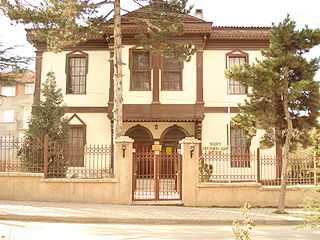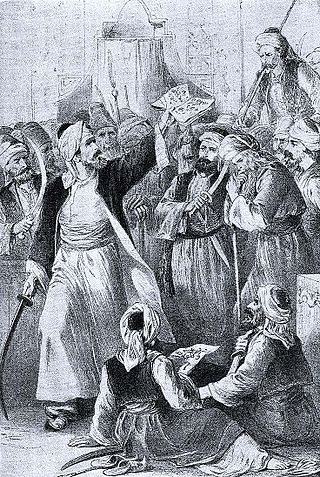
Osman I or Osman Ghazi was the eponymous founder of the Ottoman Empire. While initially a small Turkoman principality during Osman's lifetime, his beylik transformed into a vast empire in the centuries after his death. It existed until 1922 shortly after the end of World War I, when the sultanate was abolished.

The Ottoman Turks were a Turkic ethnic group native to Anatolia. Originally from Central Asia, they migrated to Anatolia in the 13th century and founded the Ottoman Empire, in which they remained socio-politically dominant for the entirety of the six centuries that it existed. Their descendants are the present-day Turkish people, who comprise the majority of the population in the Republic of Turkey, which was established shortly after the end of World War I.

Ertuğrul or Ertuğrul Ghazi was a 13th-century uch bey (marcher-lord), who was the father of Osman I. Little is known about Ertuğrul's life. According to Ottoman tradition, he was the son of Suleyman Shah, the leader of the Kayı tribe of the Oghuz Turks. These Turkomans fled from western Central Asia to Anatolia to escape the Mongol conquests, but he may instead have been the son of Gündüz Alp. According to this legend, after the death of his father, Ertuğrul and his followers entered the service of the Sultanate of Rum, for which he was rewarded with dominion over the town of Söğüt on the frontier with the Byzantine Empire. This set off the chain of events that would ultimately lead to the founding of the Ottoman Empire.

Anatolian beyliks were Turkish principalities in Anatolia governed by beys, the first of which were founded at the end of the 11th century. A second and more extensive period of establishment took place as a result of the decline of the Seljuq Sultanate of Rûm in the latter half of the 13th century.

Bilecik Province is a province in midwest Turkey, neighboring Bursa to the west, Kocaeli and Sakarya to the north, Bolu to the east, Eskişehir to the southeast and Kütahya to the south. Its area is 4,179 km2, and its population is 228,673 (2022). Most of the province laid down in Marmara Region but eastern parts of Gölpazarı and Söğüt district and districts of İnhisar and Yenipazar remained in Black Sea Region, smaller southeastern parts of Bozüyük and Söğüt remained in Central Anatolia Region and smaller southwestern part of Bozüyük remained in Aegean Region.

Bilecik is a city in northwestern Anatolia, Turkey. It is the seat of Bilecik Province and Bilecik District. Its population is 74,457 (2021). The mayor is Melek Mızrak Subaşı (CHP).
Küre is a village in the Söğüt District, Bilecik Province, Turkey. Its population is 953 (2021). Before the 2013 reorganisation, it was a town (belde). It is 12 kilometres (7.5 mi) north of Söğüt and 24 kilometres (15 mi) east of Bilecik. The town was founded in the 13th century. Later Turkmen tribe of Kayı also settled in the village. The second sultan Orhan commissioned a mosque in the town. Another building referring to the history of the town is a türbe ("tomb") which is thought to be of Dursun Fakih, brother in law of Osman I.
Hayme Hatun, also known as Hayma Ana, was the grandmother of Osman I, who was the founder of the Ottoman Empire. She was the mother of Ertuğrul Gazi, Gündoğdu, who were the leaders of the Kayı clan of the Oghuz Turks. She was bestowed and known by the title of Devlet Ana of the Ottoman Empire.

Diriliş: Ertuğrul, translated as Resurrection: Ertuğrul, is a Turkish historical fiction and adventure television series produced by Mehmet Bozdağ for TRT, starring Engin Altan Düzyatan as Ertuğrul Bey. The show is set in the 13th century and is based on the life of Ertuğrul, the father of Osman I, the founder of the Ottoman Empire.

The Qiniq were an Oghuz Turkic ("Turkmen") tribe.

Söğüt Ertuğrul Gazi Museum is a museum in Söğüt ilçe (district) of Bilecik Province, Turkey.
Kuruluş: Osman, translated as Establishment: Osman, is a historical fiction Turkish television series produced by Bozdağ Film. It tells the story of the life of Osman I, founder of the Ottoman Empire.

After the death of Ertuğrul's father, the Oghuz Turkic Kayı tribe was divided when Ertuğrul's elder brothers, Gündoğdu Bey and Sungurtekin Bey, decided to migrate to Central Asia, while Ertuğrul and his younger brother Dündar wanted to migrate to Söğüt.
The Siege of Kulacahisar or Raid of Kulacahisar was a battle fought between the Byzantines and the Turks under the command of Osman Gazi in 1285 for control of Fort Kulaca.

Ertuğrul Bey is the main protagonist in the Turkish TV series, Diriliş: Ertuğrul, portrayed by Engin Altan Düzyatan. He also appears in the sequel, Kuruluş: Osman, where he is played by Tamer Yiğit and is referred to as Ertuğrul Gazi. The character is based on Ertuğrul, the father of Osman I.

Osman Bey is the main protagonist in the Turkish TV series, Kuruluş: Osman, portrayed by Burak Özçivit. He also appears as a supporting character in its predecessor, Diriliş: Ertuğrul, where he is played by Emre Üçtepe. The character is based on Osman I, founder of the Ottoman Empire.

The siege of İnegöl took place between Agios Nikolaos, the governor of the fort, and the Kayı army under the command of Turgut Bey. This conquest was one of the first conquests in Ottoman history after the siege of Kulaca Hisar. After the end of the siege, Tekfur Nikolaos was executed by Turgut Alp. The conquest took place in 1299. This battle triggered the Battle of Bapheus, where the Byzantines attempted to reconquer the lost territory, which in turn led to the siege Of Bursa eventually leading to the establishment of Ottoman Beylik.
















